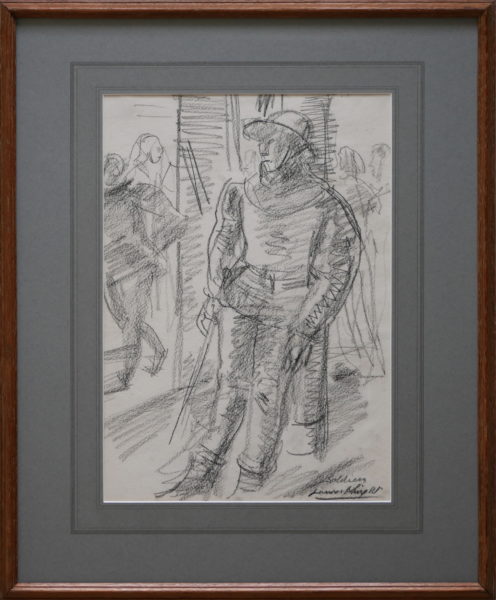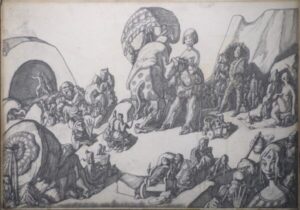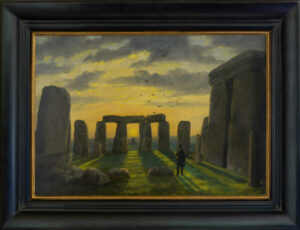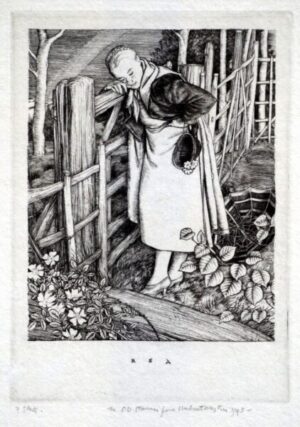Knight, Laura (1877-1970)
Laura Knight surnamed Johnson at birth, was born on August 4, 1877, in Long Eaton, Derbyshire. She was a third daughter of Charles Johnson and Charlotte Johnson who had two more daughters, Nellie and Eva. Laura never saw her father who died on August 14, 1883, because he left the family soon after her birth.
Laura’s grandfather was the owner of a lace-making factory, but the business had serious problems because of the lack of new facilities.
Laura’s mother worked as a teacher at the Brincliffe school for girls and gave lessons to private art pupils in order to provide the family with extra money.
In 1889, Laura Knight lost her elder sister Nellie, who died of pneumonia and her great-grandmother, Charlotte Ther. Four years later, Laura’s mother died too, so, Laura and her sister Eva became orphans.
Education
Laura Knight started her artistic training in 1889 when she was sent to her relatives in northern France in order to study art at Paris workshops. Unfortunately, after some time in Paris, Laura had to come back to the United Kingdom because of her own financial problems and the bankruptcy of the French relatives.
At the age of thirteen, Knight became a student at the Nottingham School of Art without paying fees due to her mother who worked part-time at the institution. While at the School, Laura met Harold Knight who became her close friend. Five years later, they both left the School.
In June 1931, Laura gained a Doctor of Laws in English honorary degree from St. Andrews University. Twenty years later, she was awarded an Honorary Doctor of Letters degree by the Nottingham University.
Career
Laura Knight’s first professional steps can be counted from her teaching duties at the Brincliffe school for girls which she accomplished instead of her mother when the latter turned sick. At the time, Laura was still a young girl aged fifteen. However, she had remained with her teaching activity even after her mother’s death in 1893, giving private painting lessons.
The beginning of the 1900s was rich for the artistic self-development of Laura and her life partner Harold Knight. So, in 1894, the couple visited Staithes village and had lived there for some time founding Staithes Art Club in 1901. The first exhibitions at which they both took part was organized in 1906 at the Leicester Galleries in London. By that time, Harold Knight was already an accomplished portraitist while Laura still continued to elaborate on her artistic mind. After a few trips to the Netherlands, in 1907, the couple settled down in Lamorna village at west Cornwall and joined the Newlyn School of artists, which included Lamorna Birch and Alfred Munnings. The Knights became leading figures of the group.
A year after, the participation at the exhibitions increased and included the presentations of some works at The Royal Hibernian Academy, Newlyn Art Gallery, Royal Academy (1909 and 1911, with The Beach and Daughters of the Sun in accordance), New English Club, Walker Art Gallery Liverpool, and the Royal Birmingham Society of Artists.
At this time, Laura started to use ballet as the subject for her paintings some of which were exhibited at the Leicester Galleries, London in 1912. The painting called The Green Feather depicting Laura’s friend and model Dolly Shell was sent by the painter to the international exhibition at the Carnegie Institute in Pittsburgh. The picture was bought by the National Gallery of Canada for £400.
In 1913, Laura Knight created one of her most known masterpieces, Self Portrait with Nude. The picture was complex in composition and somehow revolutionary among the self-portraits made by women at that time. With mirrors, Knight managed to depict herself painting a nude model, the artist Ella Naper as if they both were seen by someone looking at the scene from the back. The painting was presented to the public for the first time in 1913 at the Passmore Edwards Art Gallery in Newlyn and received very good reviews from local press and colleagues. Despite the fact that the Royal Academy did not accept the painting for exhibition and a bad opinion from the Daily Telegraph's art critic, it was exhibited at the International Society of Sculptors, Painters and Gravers in London, entitled The Model. The painting was exhibited throughout Laura’s career and continued to be criticized.
A year later, Laura had her debut exhibition in the United States. In the same period, she also exhibited her enamel creations showing ballet dancers at the Fine Art Society in London in 1915 and another picture called Spring at the Royal Academy in 1916. The same year, after the outbreak of the First World War, the artist was commissioned to paint a picture for the Canadian Government War Records office called ‘Physical training in Witley Camp’, which provided the artist with £300. During the War, Knight received the status of the conscientious objector and worked as a farm labourer.
In 1919, Laura exhibited for the first time in Canada. The next year, she got acquainted with a Russian ballerina Anna Pavlova and started to paint her and other famous participants of the Ballets Russes by Sergei Diaghilev, like Lydia Lopokova, and the dance teacher Enrico Cecchetti. Laura’s artworks by that time also featured backstage and dressing rooms. Laura Knight bought Sir George Clausen's printing press and started to produce her first etchings and to depict the circus personages, in particular those of the Fossett Circus, Agricultural Hall Islington, and Bertram Mills Circus (the clown Whimsical Wilson). From 1923 in two years, she made in total about 90 prints, among which was a poster advertising tram travel to Twickenham for London Transport.
In 1922, the artist made her first trip to the United States in order to take part in the International Art Exhibition of Pictures in Pittsburgh as a jury member. The following year, appeared her publication called Laura Knight: A book of Drawings with an introduction by Charles Marriott. The same year, Laura exhibited her artworks in Paris.
Laura Knight’s activity as a designer started in 1924 from the collaboration with Stanislav Idjkowski for whose ballet the artist created the costumes. One more similar project of the time was the theatre production by Sir Barry Jackson in 1927.
The exhibition at which Laura's paintings created in the early 1920 and featuring the circus scenes and its characters, took place in 1930 at the Alpine Club Gallery in London. Among others, were such pictures as Charivari or The Grand Parade and The Three Clowns. The show was badly received and criticized. Other significant works of this period are Susie and the Wash-basin (1927), Blue and Gold (1927), A Cottage Bedroom (1929), and Spring in St. John's Wood (1933).
At the beginning of the next decade, Laura Knight exhibited in Toronto, Canada, and in the United States with her watercolours and etchings, both in 1931. A year later, she also presented her prints in Chicago. Among Laura’s designer projects of the period were Cadburys’ chocolate boxes and wrappers (1933) and table service and glassware collection by Clarice Cliff named ‘Circus’ (1934). The latter was demonstrated under the title ‘British Art in Industry’ at the Royal Academy in 1935 and a year later in Australia. In 1936, Laura published her next book dubbed Oil Paint and Grease Paint.
The subjects of Knight’s paintings of this period became Gypsies. One of Laura’s regular models was Lilo Smith who appeared on such artworks as Old Gypsy Women (1938) and Gypsy Splendour (1939), as well as her daughter-in-law named Beulah. These Gypsy artworks were exhibited in 1939 at the Royal Academy.
At the outbreak of the Second World War, Laura Knight signed the contract with War Artists' Advisory Committee and became an official war artist. The artist created in total seventeen paintings among which were the pictures featuring brave women of the war. These paintings included such titles as Corporal J. D. M. Pearson, GC, WAAF (1940), Corporal J. M. Robbins (1940), Corporal Elspeth Henderson, and Sergeant Helen Turner (1941) and were exhibited during the War at the National Gallery.
Despite the war drawings, the artist also had several personal commissions, one of which was a picture called Betty and William Jacklin.
At the end of the War, the War Artists' Advisory Committee accepted Laura’s proposition to create the series of the Nuremberg war crimes trials. From January 1946 for three months, the artist observed the main process and created a painting titled The Nuremberg Trial.
One of the first projects of the post-war period for the artist became the portrait of Princess Elizabeth and her notable accompanies at the opening ceremony of the new Broadgate Centre in Coventry. In 1952, Laura Knight exhibited about eighty pictures at the Ian Nicol Gallery in Glasgow. Then, the artist returned to her early topics, theatre, and ballet. She produced drawings backstage of the production of Henry VI by William Shakespeare at The Old Vic in London and depicted the backstage of Bolshoi Ballet performances at the Royal Opera House.
The next autobiography Laura Knight wrote, The Magic of a Line, came in 1965. The same year, the artist became the first woman awarded a retrospective of her 250 works at the Royal Academy. Two other retrospectives celebrating the 75th anniversary of the painter’s career were organized in 1968 and 1969 at the Upper Grosvenor Galleries.
Achievements
Laura Knight had a long and successful artistic journey and created a huge number of masterpieces covering different art genres and topics, including landscapes, portraiture, design (ballet, theatre, and tableware), war commissions, animals, and racehorses, seascapes, circus, and gypsies.
She is justly considered as one of the main woman artists of Britain of the time whose artistic style influenced and encouraged future generations.
Such characteristics as ‘first’ and ‘only’ were permanent companions throughout Laura’s career. So, the artist was the first woman who received the title of Dame of the British Empire and the first woman elected at the Royal Academy of arts since its creation in 1768. She was also the only woman having a retrospective at the institution and in fact the only one who presented her artworks there annually since 1903. The total number of her artworks exhibited there attends 284, plus 176 pieces at the retrospective. Other similar records are related to the Royal Watercolour Society – over 190 works in 40 years from 1930, and the Leicester Galleries – over 400 works. In fact, Laura had a great number of exhibitions all around the world, including the United States, Canada, South Africa, Australia, New Zealand, Israel, and Europe.
Laura Knight was the only woman artist who was an official war painter during the Two World Wars.



